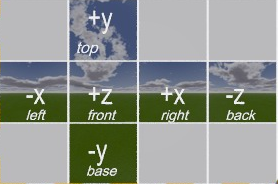There is a new class named Skybox in this project. The Skybox inherits from the Model class. Typically, you use inheritance to modify or extend the behavior of the base class. The summary behavior of the skybox is:
-
Reverse the normals of the cube model, because the viewer is always inside the box. If normals did not reverse, the backface culling stage of OpenGL pipeline would eliminate the rendering of the skybox. Instead of designing a special cube with normals facing inward, we can control the winding order of front-facing polygons:
glFrontFace( GL_CW ); // clock-wise triangles are now front-faced //... skybox->render(); glFrontFace( GL_CCW ); // restore counter-clock-wise front-face mode -
When the viewer looks around the scene, the skybox should rotate with the scene, acting as a scene backdrop.
-
We discussed in the past that the result of the model/view transformation is that the camera ends up sitting at the coordinate
(x, y, z) = 0, 0, 0This is because the camera never moves; instead, all objects move and rotate around the camera. So what about the skybox? We said that it does rotate, but it should never move relative to the camera. A new member function, FPSCamera::set_skybox_uniform_view_perspective(), will handle this requirement.
-
Instead of a regular texture image, the Skybox::render() function has to load a cube map texture. The cube map actually is made of six texture images -- the up, down, left, right, forward, and backward view:

Loading those six images becomes a direct responsibility of the Skybox class.
-
The skybox shader doesn't have to worry about light or the material properties. It uses raw texture to draw the backdrop environment: